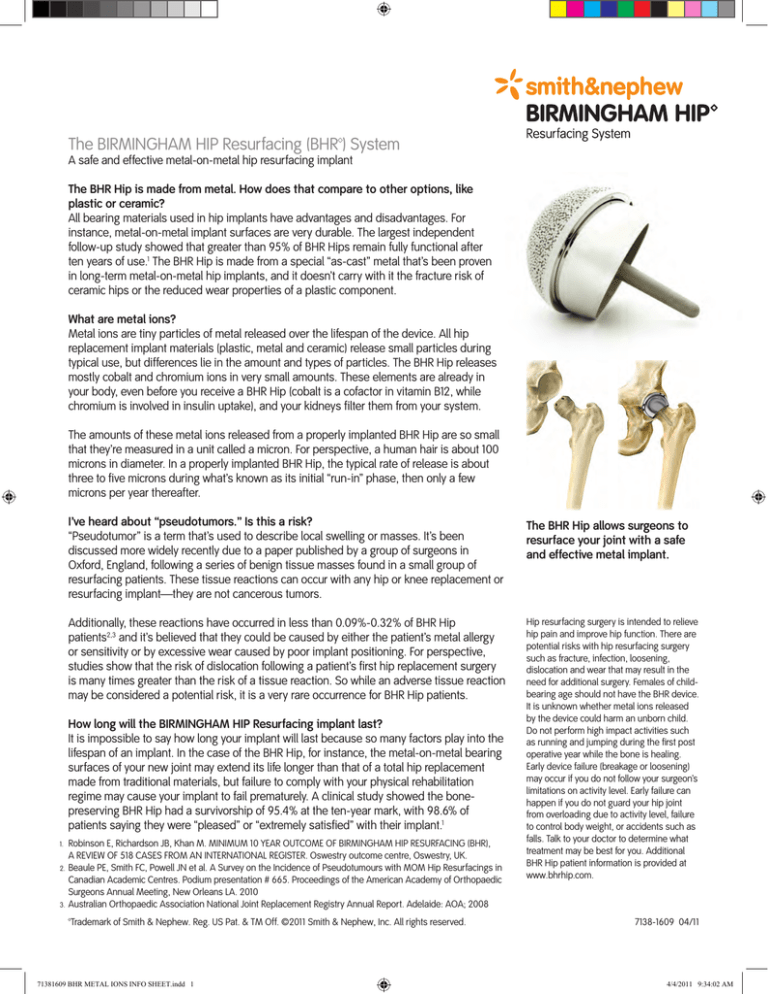
The BIRMINGHAM HIP Resurfacing (BHR™) System
A safe and effective metal-on-metal hip resurfacing implant
The BHR Hip is made from metal. How does that compare to other options, like
plastic or ceramic?
All bearing materials used in hip implants have advantages and disadvantages. For
instance, metal-on-metal implant surfaces are very durable. The largest independent
follow-up study showed that greater than 95% of BHR Hips remain fully functional after
ten years of use.1 The BHR Hip is made from a special “as-cast” metal that’s been proven
in long-term metal-on-metal hip implants, and it doesn’t carry with it the fracture risk of
ceramic hips or the reduced wear properties of a plastic component.
What are metal ions?
Metal ions are tiny particles of metal released over the lifespan of the device. All hip
replacement implant materials (plastic, metal and ceramic) release small particles during
typical use, but differences lie in the amount and types of particles. The BHR Hip releases
mostly cobalt and chromium ions in very small amounts. These elements are already in
your body, even before you receive a BHR Hip (cobalt is a cofactor in vitamin B12, while
chromium is involved in insulin uptake), and your kidneys filter them from your system.
The amounts of these metal ions released from a properly implanted BHR Hip are so small
that they’re measured in a unit called a micron. For perspective, a human hair is about 100
microns in diameter. In a properly implanted BHR Hip, the typical rate of release is about
three to five microns during what’s known as its initial “run-in” phase, then only a few
microns per year thereafter.
I’ve heard about “pseudotumors.” Is this a risk?
“Pseudotumor” is a term that’s used to describe local swelling or masses. It’s been
discussed more widely recently due to a paper published by a group of surgeons in
Oxford, England, following a series of benign tissue masses found in a small group of
resurfacing patients. These tissue reactions can occur with any hip or knee replacement or
resurfacing implant—they are not cancerous tumors.
The BHR Hip allows surgeons to
resurface your joint with a safe
and effective metal implant.
Additionally, these reactions have occurred in less than 0.09%-0.32% of BHR Hip
patients2,3 and it’s believed that they could be caused by either the patient’s metal allergy
or sensitivity or by excessive wear caused by poor implant positioning. For perspective,
studies show that the risk of dislocation following a patient’s first hip replacement surgery
is many times greater than the risk of a tissue reaction. So while an adverse tissue reaction
may be considered a potential risk, it is a very rare occurrence for BHR Hip patients.
Hip resurfacing surgery is intended to relieve
hip pain and improve hip function. There are
potential risks with hip resurfacing surgery
such as fracture, infection, loosening,
dislocation and wear that may result in the
need for additional surgery. Females of childbearing age should not have the BHR device.
It is unknown whether metal ions released
by the device could harm an unborn child.
Do not perform high impact activities such
as running and jumping during the first post
operative year while the bone is healing.
Early device failure (breakage or loosening)
may occur if you do not follow your surgeon’s
limitations on activity level. Early failure can
happen if you do not guard your hip joint
from overloading due to activity level, failure
to control body weight, or accidents such as
falls. Talk to your doctor to determine what
treatment may be best for you. Additional
BHR Hip patient information is provided at
www.bhrhip.com.
How long will the BIRMINGHAM HIP Resurfacing implant last?
It is impossible to say how long your implant will last because so many factors play into the
lifespan of an implant. In the case of the BHR Hip, for instance, the metal-on-metal bearing
surfaces of your new joint may extend its life longer than that of a total hip replacement
made from traditional materials, but failure to comply with your physical rehabilitation
regime may cause your implant to fail prematurely. A clinical study showed the bonepreserving BHR Hip had a survivorship of 95.4% at the ten-year mark, with 98.6% of
patients saying they were “pleased” or “extremely satisfied” with their implant.1
Robinson E, Richardson JB, Khan M. MINIMUM 10 YEAR OUTCOME OF BIRMINGHAM HIP RESURFACING (BHR),
A REVIEW OF 518 CASES FROM AN INTERNATIONAL REGISTER. Oswestry outcome centre, Oswestry, UK.
2. Beaule PE, Smith FC, Powell JN et al. A Survey on the Incidence of Pseudotumours with MOM Hip Resurfacings in
Canadian Academic Centres. Podium presentation # 665. Proceedings of the American Academy of Orthopaedic
Surgeons Annual Meeting, New Orleans LA. 2010
3. Australian Orthopaedic Association National Joint Replacement Registry Annual Report. Adelaide: AOA; 2008
1.
™Trademark of Smith & Nephew. Reg. US Pat. & TM Off. ©2011 Smith & Nephew, Inc. All rights reserved.
71381609 BHR METAL IONS INFO SHEET.indd 1
7138-1609 04/11
4/4/2011 9:34:02 AM




![J-2 Employment Authorization Request - (sample cover letter) [Date] [Your name]](http://s2.studylib.net/store/data/015629164_1-e977b08d691444cc342f7986bccc89cd-300x300.png)

